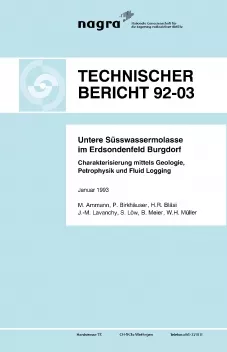
Technischer Bericht NTB 92-03
Untere Süsswassermolasse im Erdsondenfeld BurgdorfCharakterisierung mittels Geologie, Petrophysik und Fluid Logging
In the Burgdorf geothermal test field, 13 boreholes were drilled into the Lower Freshwater Molasse (USM) over an area 14 m by 14 m. The USM consists here of sandstone formations varying in thickness from 1 m to around 20 m. The architectural features of the sediment facies include meander belts, crevasse channels and crevasse splays, with intercalated low-permeability units of natural levee and flood plain sediments up to 15 m thick.
Supplementary investigations were performed in five of the boreholes and these form the subject-matter of this report. These included extending borehole M 1400 from a depth of 100 to 250 m, detailed logging of the cored boreholes M 1400 and M 2100 (description of lithofacies and identification of architectural elements), fluid logging in borehole M 1400, petrophysical measurements in boreholes M 1400, M 2100, E 2100 and E 2200 and, finally, a series of laboratory experiments on samples from borehole M 1400. The aim of these investigations was to improve the geological, petrophysical and hydrogeological characterisation of the five architectural elements encountered, as well as their identification using petrophysical logging techniques. Particular significance was attached to elements with permeable sandstones.
The geological investigations included determining the lithofacies and the architectural elements of the facies in two cored boreholes. Numerous samples from borehole M 1400 (particularly sandstone samples from meander belts, crevasse channels and crevasse splays) were used in laboratory tests to determine mineralogical composition and parameters such as rock density, grain density, open porosity, total porosity and permeability. The fine and medium sandstones were identified as litharenites and feldspar-rich litharenites according to the triangular diagram "quartz-feldspars-rock clasts" from FOLK (1974). The diagenesis of the sandstones is relatively straightforward, with compaction followed by calcitic cementation and partial dissolution of feldspars and rock clasts. The total porosities of samples from architectural elements composed mainly of sandstones vary between 10 to 25 %. The open porosities are between 4 and 21 % and the permeabilities between 3 and 5660 md. Meander belt and crevasse channel sandstones have a permeability distribution with maximum values in the centre and minimum values above and below. Permeable sandstone sections are always bounded by marly strata with a low porosity and no measurable permeability.
Fluid logging techniques (conductivity logging and packer-flowmeter logging) were used in borehole M 1400 to carry out a hydrogeological characterisation of the permeable zones of the USM. The following basic guidelines are of assistance when deciding on the method to be used:
- If, with feasible pumping and drawdown rates (or injection), more than approx. 5 I/min can be extracted (or injected) from the borehole interval being tested (5 E-3 m2/s > Ttot > 1 E-7 m2/s), the packer-flowmeter method is recommended.
- If lower permeability sections (5 E-4 m2/s > Ttot > 1 E-10 m2/s) with pumping rates in the range up to 5 I/min are to be tested and the individual flow paths characterised, then the conductivity method is more appropriate.
Transmissivities of 2 E-5 to 2 E-7 m2/s were measured in borehole M 1400; taken in relation to the thickness of the sandstone elements, this gives K values of 4 E-6 to 4 E-8 m/s. 7 of the 9 inflow points identified were located in meander belts, and the other two in crevasse channels/crevasse splays. Two meander belts had no identifiable inflow points. The architectural features located between the inflow points (clay- and silt-rich flood plain sediments) function as effective hydraulic barriers which prevent any balancing out of the relatively large differences in potential observed over short vertical distances in borehole M 1400.
The petrophysical measurements included a survey of four boreholes (caliper log, gamma log, density log and neutron porosity log). In two of the boreholes which were already cased and infilled with gravel, no quantitative measurements were possible but the gamma logs could be used for "layer correlations" with the other boreholes. Measuring conditions in the two uncased boreholes were good and the sandstone units could be delimited using mainly gamma and density logs. However, in the area of borehole breakouts, the caliper corrections required for calculating the density and porosity values are unsatisfactory. Sandy units can be detected using petrophysical measurements, without any geological input. Because of their low clay content, the channel sandstones are characterised by very low intensities of gamma radiation. A special study carried out using the petrophysical logs from borehole M 1400 showed that, even without any core analysis, the USM can still be characterised in some detail (i.e. divided into architectural elements) using the petrophysical dataset available.
The following information was obtained on the subsurface layer geometry in the Burgdorf investigation area. Based on all the data collected from a total of five boreholes, the strata presumably dip to the ESE, with an angle of approx. 10°. Since the gamma logs from four of the boreholes are more or less identical over large depth ranges, the subsurface geometry would appear to be very simple. The presence of extensive disturbed zones can be ruled out. However, some small-scale disturbed zones could be detected on the basis of drillcore photos (disturbed zones with a dip of 60°; presumably normal faults, azimuth unknown) and analysis of gamma logs. Spatial orientation of these zones is not possible, and it is therefore impossible to obtain an exact picture of the three-dimensional structure of the underground of the Burgdorf geothermal test field.
